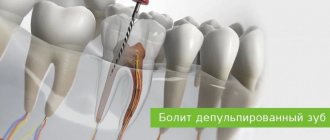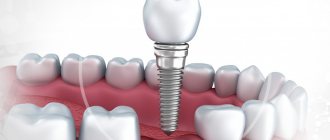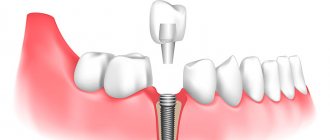Publication date: 03/21/2020
Indications for tooth extraction include dental diseases that cannot be treated conservatively or surgically. Sometimes the dentist is unable to save a tooth from irreversible pulpitis caused by root canal obstruction or insufficient tooth tissue needed for reconstruction, in situations where the patient presents to the clinic too late. Indications for removal also include: weakening of tooth roots, recurrent inflammation of the periapical region. Often a tooth is removed for orthodontic reasons. During the diagnostic process, the orthodontist may come to the conclusion that there is not enough space for large teeth in a small jaw. A tooth can also break or crack as a result of trauma to the facial part of the skull. However, not all damaged teeth are doomed to be removed.
Separately, it is worth highlighting tooth extraction as part of a one-stage implantation plan. That is, when a tooth is removed and an implant is immediately installed in the newly formed hole. This procedure can be carried out provided that:
- The alveolar process is of sufficient size and does not require the addition of artificial bone replacement material.
- There is no need to perform a sinus lift. Some doctors delay implantation for 4-6 months after this procedure, others decide to implant immediately after raising the floor of the maxillary sinus. Evaluation of the choice of method is the responsibility of the implantologist and largely depends on the individual clinical picture.
- There are no systemic contraindications.
What is the procedure?
When a tooth is removed, the alveolar bone begins to decrease in size due to a decrease in load, cessation of blood supply and metabolic processes. Both height and thickness change. To preserve the volume of bone tissue and subsequent successful implantation, the hole is filled with a special osteogenic composition. It creates a frame and prevents further bone loss. Preparing the hole after tooth extraction before implantation is most relevant for the upper jaw, which includes air cavities. In this case, the frontal parts are especially important due to their aesthetic significance.
Types of one-stage implantation
There are two methods of dental prosthetics based on one-stage implantation. The first is a classic two-stage one (shown in the diagram). The algorithm is as follows: tooth extraction with simultaneous implant integration, gum suturing for the period of osseointegration (implantation) for 3 – 6 months. After successful engraftment, the gum is opened and an abutment (an adapter between the artificial root and the coronal part) is installed on the implant. Finally, a crown is fixed onto it. The second option for simultaneous implantation is one-stage. When it is implemented, a prosthesis is immediately attached to the installed implant, but at first it is temporary. This is due to the fact that the newly installed artificial root cannot be given full load. This threatens implant rejection. Therefore, fixation of the permanent prosthetic structure is performed only after completion of the osseointegration process.
Note: “one-stage” and “one-stage” implantation techniques are not the same thing. One-stage can be performed in one or two stages, but one-stage is not always one-stage, since an artificial root can be installed in place of a long-removed element of the dentition. The network of clinics “Smile” performs all types of implantations. The operations are performed by highly qualified specialists using the latest diagnostic equipment and implantation systems from well-known manufacturers.
How is the socket prepared for implantation?
The entire procedure takes place under anesthesia, so the patient will not feel pain or discomfort. It is important for the patient to choose effective anesthetic drugs that do not cause allergies and eliminate all pain. Therefore, when creating a treatment plan, pay more attention to preparation and diagnosis. During the procedure, the implantologist will perform the following actions:
- Treat the surgical site with an antiseptic.
- Fill the hole with a bone-forming compound.
- Cover with a special hypoallergenic membrane.
- Fixes the surgical surface by tensioning the free edges of the connective tissue.
- He will put stitches.
Advantages of dental implantation under general anesthesia
One of the main advantages of implantation using general anesthesia is that it becomes possible to create the most comfortable conditions for a person who has decided to treat teeth with surgery.
At the same time, the procedure makes it possible to simultaneously solve other problems that are associated with dental treatment. The advantages of this type of anesthesia also include a significant reduction in time expenditure, since the volume of therapeutic manipulations, which are designed to last several weeks, can be done in one visit to the dentist.
When is it necessary to prepare a hole for implantation?
If the bone volume is insufficient for implantation, the implantation operation will not be possible, so preliminary preparation is required. It is also recommended:
- To eliminate the risk of injury to the maxillary sinuses.
- When planning orthodontic treatment.
- When it is impossible to stabilize the implant in the tooth socket after removal.
- With age-related changes, bone tissue undergoes anatomical and physiological changes over time.
- To secure and extend the service life of any dental implant.
The material used is a synthetic biocompatible mass in granules, barrier membranes that are removed independently as new bone grows, or a connective tissue graft.
Tooth extraction process
If the indications for removal are clear, the dentist needs to remove the tooth. After selecting and administering anesthesia, the doctor begins the procedure. Let us immediately note that the entire process is absolutely painless. Patients of the ILATA clinic feel the maximum - pressure, but no pain!
It consists of several successive stages. In the first stage, the dentist uses special instruments to tear the circular ligament surrounding the tooth. The next step involves using forceps to extract the tooth. To facilitate this process, the doctor makes appropriate movements so that the periodontal fibers are weakened. A “weakened” tooth can be easily removed from its socket. But this is not the end of the procedure. The doctor thoroughly cleans the alveolus so that there are no remnants of pathological tissue, bone fragments or tooth fragments. This is the process of regular tooth extraction, but what is the difference between extraction and immediate implantation?
Indications and contraindications
Indications for the procedure:
- To prevent bone loss. — To eliminate defects associated with periodontal disease. — Creation of an optimal contour of bone and soft tissue to preserve the anatomical features of this area. — To ensure a good aesthetic result.
There are contraindications:
— Acute infectious diseases of the nasopharynx and oral cavity. — Oncological diseases. — Pregnancy and breastfeeding. — In immunodeficiency states. — State of acute pain after removal.
Proper planning
At the stage of preparation for removal, it is important to obtain maximum information about what is hidden under the gum - the number of roots, the direction of their growth, length, possible bends, etc. This data will help you plan the removal process correctly, which will ensure minimal trauma to the bone tissue. Therefore, the patient is first given:
- radiography,
- orthopantomography,
- tomography of the jaw.
What should not be done after preparing the hole for implantation?
To prevent the inflammatory process in the operated part, it is necessary to stop smoking and physical activity. Eating solid and hot foods is contraindicated; it should be gentle. Excessive load on the jaw should not be allowed. Chew on the healthy side. Neglecting oral hygiene is contraindicated. The procedure is quite simple and effective for preserving the bone and the most natural contours of the alveolar socket. It will save time and costs on expensive procedures in the future.
Yandex Zen: Preparing the socket of an extracted tooth for implantation in the 1st quadrant area
How are dental implants removed?
Is it difficult to remove a dental implant? Yes and no. On the one hand, the mechanical side of the matter is extremely simple. It is not difficult to unscrew an implant from the jaw (especially if it is movable), but only an experienced implantologist can do this correctly and as non-traumaticly as possible. In addition, important blood vessels and nerve bundles often pass through the implantation area, so damage to them can cause additional serious complications. In general, implant removal usually takes one visit and takes place in several stages.
- The doctor removes the crown or full denture.
- An incision is made in the gum.
- The implant is removed.
- If necessary, appropriate therapeutic or surgical manipulations are performed (treatment of affected areas, plastic surgery of soft and hard tissues).
- After identifying the cause of rejection, a subsequent rehabilitation plan is developed.
Implant removal usually occurs under local anesthesia or sedation. If everything is done correctly, the consequences of removing a dental implant will be relatively mild and the patient will be able to recover in a short period. After completion of the rehabilitation period, in most cases, re-implantation is possible, unless absolute contraindications to the procedure have been identified. It is quite difficult to find reviews on the Internet about the removal of a dental implant (even less about complications), but if it is done by a professional, then you have nothing to fear.
If complications occur, you should contact the same clinic where the treatment was performed. If implant rejection was not your fault, then most dentists undertake to provide free treatment and a repeat implantation procedure (or return the money if it is not possible). In addition, almost all major manufacturers also provide a lifetime warranty on their products. Startsmile recommends undergoing treatment in trusted clinics that offer an appropriate guarantee.
Alternatives
Fear of dentists is based mainly on memories from childhood, when the level of dentistry in the country was low. Recently, Russian dentistry has been confidently applying advanced methods and techniques. Our doctors participate in conferences and symposiums and exchange experiences with colleagues from other countries. The level of dental services has literally reached world heights. Gone are the days when thick needles, huge syringes and lidocaine as an analgesic were used to administer local anesthesia.
Now the injection into the gum is almost not felt, and if you are still afraid of it, you can first numb the pain with a gel. After the introduction of a modern analgesic, the patient does not feel pain from the word “at all.” You can open the gum, saw the bone, remove roots, screw in implants - there will be no pain. At the same time, the patient is completely adequate, responds to stimulation, follows instructions, and takes part in the process. No mind games or risks associated with respiratory depression or heart rhythm disturbances.
There are few contraindications and consequences for local anesthesia; the experience of its use is so vast that complications are practically excluded.
For patients with increased anxiety, we can recommend publicly available sedatives: herbal decoctions and teas, Persen. These are over-the-counter products, they have a shallow effect, but quite sufficient to relax before the procedure.
There are also methods of non-drug sedation:
- friendly staff;
- pleasant environment;
- light music;
- friendly doctor and assistant.
All this helps to calm down and survive implantation, without using mind-controlling substances.
For a highly qualified implantologist, performing implantation under local anesthesia is no more difficult than placing a dental implant under anesthesia.
Operation stages
The standard technique involves performing a number of sequential manipulations:
- Antiseptic treatment of the oral cavity using bactericidal solutions to prevent infection of the exposed root canal;
- Introduction of anesthetic drugs - ultracaine or lidocaine - provided there is no allergy to the components included in their composition;
- Treatment of a carious cavity using a drill, followed by expansion of the dental canal and removal of dead tissue;
- Removing the nerve using a pulp extractor, the design of which resembles a needle with a thick handle;
- Stopping bleeding that occurs due to damage to capillary vessels - using hemostatic agents or thermal coagulation;
- Installation of a temporary filling made of composite material, which after a certain period is replaced with a permanent inlay.
One of the common methods of nerve devitalization is arsenic loading. Modern techniques make it possible to exclude the procedure from the protocol, but some experts consider it advisable.
What to do if the pain under the crown does not go away
Painful sensations persist in the first days after depulpation, and are characterized by a gradual decrease in intensity. Factors that cause swelling or increased sensitivity include:
- Violation of the natural anatomical structure of the root canal;
- Poor cleaning of the cavity from the remains of the pulp structure;
- Making technical errors in the manufacture of a prosthesis;
- Low quality of material taken for filling;
- Inflammation resulting from tissue damage.
If the pain syndrome worsens at night and is characterized by pulsating manifestations, it is recommended to immediately consult a dentist to eliminate the possibility of the development of pathological inflammatory processes.
Nutrition.
- Avoid drinking alcoholic beverages several days before implantation, at least 1-2 days. Alcohol reduces blood clotting and reduces the analgesic effect of anesthetics.
- Limit or completely eliminate coffee consumption for a couple of days, as this can negatively affect blood pressure.
- The diet should be varied, including a complex of vitamins and minerals. The diet should include vegetables, herbs, fruits, meat, chicken, fish, eggs, milk, cheese.
Sedation or anesthesia
If you choose the lesser of two evils, then dental implantation under sedation is preferable to general anesthesia. But its use must be taken responsibly, weighing all the pros and cons.
The use of sedation is indicated for:
- severe dental phobia (up to panic attacks);
- highly developed gag reflex;
- mental or mental problems that make it difficult to follow instructions.
Local anesthesia, sedation, anesthesia
For a long time, all implantation operations were performed under local anesthesia. Nowadays, more and more clinics prefer to perform dental implantation during sleep. This is very convenient for the doctor and creates ideal working conditions. The advertisement claims that this is convenient for the patient: he falls asleep without teeth and wakes up with a dazzling smile. But any medical procedure must have a justification and be carried out only if refusing it entails more problems than using it.
First, let's understand the terms. Inhibition of consciousness with the help of medications has several stages:
- Lightweight
- Moderate
- Deep
- General anesthesia
The first 3 stages in medicine are called sedation, and only the 4th is considered anesthesia. In ordinary life, we call all stages anesthesia. This introduces some confusion in the use of concepts.
Local anesthesia is the numbing of the surgical field. An analgesic is administered to the area where the manipulation will be performed. Most often, this is an injection into the gum. The pain is blocked in a certain area, the patient is conscious.
Sedation
– a state of psycho-emotional inhibition, relaxation, in which protective reflexes, independent breathing and reaction to stimuli are preserved.
Sedation does not relieve pain
, but helps to calm down and reduces psycho-emotional discomfort. An example of mild sedation would be taking valerian or other sedatives.
General anesthesia
– artificial deep sleep with suppression of reflexes, disabling pain, and the inability to breathe independently. Anesthesia turns off consciousness, reduces the body's response to injury, and relaxes muscles.
Often, in dentistry, the same drugs are used for deep sedation and general anesthesia. Therefore, when it comes to the consequences of anesthesia, the same can be applied to sedation.
General overview
Inside the dental canal there are capillaries, lymph vessels, nerve and connective fibers, which in their natural state are responsible for saturating dentin and enamel with essential minerals. Failure to comply with the dental treatment protocol, prolonged development of pathologies, as well as mechanical injuries and damage associated with destruction of the structure cause disruption of biological processes. The devitalization procedure involves killing the nerves that cause pain - arsenic is used for this, as well as other compounds placed in the cavity of the crown. Achieving the desired result allows you to move on to depulpation - expansion of the canal and removal of the affected pulp, eliminating the likelihood of recurrence of the abnormal condition.
In what cases is it necessary to donate blood for testing?
For healthy patients, it is enough to take an X-ray of the jaw before implantation. If the patient mentioned in the questionnaire about allergies, chronic diseases and other possible obstacles to surgery, additional research will be required. They are recommended for the following conditions:
- Allergy . If a patient has an allergic reaction to drugs, allergy tests are prescribed. This is necessary for choosing anesthesia.
- Taking medications to reduce blood clotting . A consultation with the attending physician is required to cancel anticoagulants for 2-3 days during the implantation period. Due to poor clotting, bleeding may begin and complications may arise.
- Diabetes. High blood sugar levels (from 12-15 mmol/l) are a contraindication to surgery. The doctor will recommend reducing your glucose level to at least 8-10 mmol/l. This will reduce the risk of implant rejection.
- Taking bisphosphonates (drugs to treat osteoporosis and some cancers). They worsen the healing process and often cause rejection of titanium roots.
Patients with cardiovascular diseases require permission for surgery from a general practitioner and cardiologist. For example, hypertension causes bleeding during implantation. There are other pathologies that require the supervision of highly specialized physicians.











